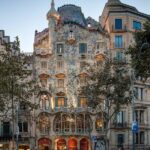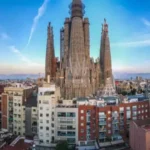
- The Architectural Genius Behind the Sagrada Familia's Design
- Exploring the Reasons for the Sagrada Familia's Incompletion
- The Historical Significance of the Sagrada Familia in Barcelona
- Understanding the Funding Challenges Facing the Sagrada Familia
- The Role of Gaudí's Vision in the Sagrada Familia's Construction
- Future Prospects: When Will the Sagrada Familia Be Completed?
The Sagrada Familia in Barcelona stands as a testament to human creativity and ambition, attracting millions of visitors each year with its breathtaking architecture and intricate details. However, its construction remains a work in progress, raising questions about the complexities behind completing this iconic basilica.
In exploring The Unfinished Marvel: Sagrada Familia Barcelona – Why Not Finished Yet?, we delve into the historical, financial, and artistic challenges that have delayed its completion. As we examine these factors, we uncover the enduring legacy of Antoni Gaudí and the ongoing efforts to fulfill his visionary masterpiece.
The Architectural Genius Behind the Sagrada Familia's Design
Antoni Gaudí, the brilliant mind behind the Sagrada Familia, infused his work with a unique blend of natural forms and innovative techniques. His design philosophy was deeply connected to the organic patterns found in nature, resulting in structures that mimic the beauty of the natural world. Notably, he employed hyperboloid structures and catenary arches, which not only enhance the aesthetic appeal but also improve structural integrity.
Gaudí's architectural genius is evident in the way he integrated geometry with spirituality. The Sagrada Familia features intricately designed facades that narrate the life of Jesus, reflecting his deep religious beliefs. Each aspect of the basilica is meticulously planned, from the towering spires to the detailed sculptures, all serving to engage the visitor in a profound spiritual experience.
Moreover, Gaudí's innovative use of materials set the Sagrada Familia apart. He combined traditional stone with modern techniques, enabling him to create complex shapes that were previously unimaginable. The following elements showcase his groundbreaking approach:
- Light and Color: Gaudí designed stained glass windows that allow natural light to flood the interior, creating a dynamic play of colors.
- Sustainable Practices: He incorporated eco-friendly methods by using locally sourced materials, making the construction process more sustainable.
- Symbolism: Every feature is laden with spiritual and cultural significance, from the number of spires to the patterns on the walls.
In summary, the architectural genius of Antoni Gaudí not only shapes the Sagrada Familia's physical form but also its spiritual essence. His visionary approach continues to inspire architects and artists around the world, proving that true creativity knows no bounds. As we await the completion of this iconic landmark, Gaudí's legacy remains a powerful reminder of the intersection of art, nature, and faith.
Exploring the Reasons for the Sagrada Familia's Incompletion
The Sagrada Familia's prolonged construction can be attributed to several entwined factors that reflect both the challenges of the past and the complexities of the present. One significant reason is the financial constraints faced throughout the years. The basilica is funded primarily through private donations, which means that the pace of construction is often dictated by the level of public support and tourism revenue. This reliance on external funding creates a fluctuating timeline and uncertainty regarding completion.
Another crucial aspect contributing to its incompletion is the technical challenges inherent in Gaudí's ambitious design. The intricate details and unique architectural features require highly skilled artisans and craftsmen, which can lead to delays. Additionally, modern construction methods and safety regulations necessitate constant adaptation of techniques to align with the original vision while ensuring structural integrity.
Moreover, the cultural and historical significance of the Sagrada Familia adds layers to the construction process. Many stakeholders, including architects and preservationists, feel a strong responsibility to honor Gaudí's original plans while also considering contemporary needs. As a result, there is an ongoing dialogue about how best to navigate the delicate balance between tradition and innovation, prolonging the timeline for completion.
In summary, the incompletion of the Sagrada Familia is a multifaceted issue involving financial, technical, and cultural challenges. Each of these elements plays a vital role in shaping the future of this architectural masterpiece, emphasizing the careful consideration required in bringing Gaudí's vision to life while ensuring the structure remains relevant in today's world.
The Historical Significance of the Sagrada Familia in Barcelona
The Sagrada Familia is not just a remarkable piece of architecture; it holds profound historical significance for Barcelona and the broader context of architectural development. Designed by Antoni Gaudí, this basilica reflects the rich cultural heritage of Catalonia, encapsulating the region's artistic evolution and spiritual aspirations. Its construction, which began in 1882, has become a symbol of perseverance, embodying the collective efforts of generations dedicated to a singular vision.
Throughout its history, the Sagrada Familia has witnessed various socio-political changes in Spain, including the Spanish Civil War and shifts in cultural sentiments. These events have influenced its design and construction dynamics, making it a living monument that tells the story of resilience and adaptation. Key historical aspects include:
- Catalan Modernism: As a quintessential example of Catalan Modernism, the Sagrada Familia illustrates the transition from traditional Gothic architecture to innovative styles that embrace creativity and individuality.
- Religious Symbolism: The basilica is a tribute to Christian faith, with its intricate design elements symbolizing various aspects of spirituality, thus enhancing its historical and cultural relevance.
- UNESCO World Heritage Site: In 2005, the Sagrada Familia was designated a UNESCO World Heritage Site, recognizing its universal value and the need for its preservation for future generations.
Moreover, the Sagrada Familia's construction has inspired a multitude of artists and architects worldwide, fostering a dialogue between tradition and modernity. The ongoing work on the basilica reflects contemporary architectural techniques while striving to remain faithful to Gaudí's original vision. This unique blend of history and innovation continues to attract scholars, tourists, and admirers, reinforcing the monument's enduring significance within both local and global contexts.
In conclusion, the historical significance of the Sagrada Familia in Barcelona transcends its architectural features. It serves as a powerful reminder of the cultural identity of Catalonia and the enduring human spirit in pursuit of artistic expression. The basilica remains a focal point of community pride and a testament to the transformative power of art and architecture throughout history.
Understanding the Funding Challenges Facing the Sagrada Familia
Understanding the funding challenges facing the Sagrada Familia is crucial to grasping why this architectural marvel remains unfinished. The construction relies primarily on private donations and ticket sales from the millions of tourists who flock to see Gaudí's masterpiece each year. This dependency on fluctuating revenue streams leads to unpredictable funding levels, significantly affecting the pace and progress of construction.
Over the years, various financial hurdles have emerged, including economic downturns that have impacted tourism and donations. As a result, the Sagrada Familia's completion has been subject to delays, with construction timelines often extended due to budget constraints. The community's support is vital, and without consistent public interest and contributions, the future of the basilica remains uncertain.
In addition to economic challenges, the complexity of the project necessitates skilled labor, which can be costly. The need for highly trained artisans to execute Gaudí's intricate designs adds another layer of financial pressure. As the project progresses, the costs can escalate, forcing stakeholders to continually seek funding solutions, including potential government support or international partnerships.
Ultimately, addressing the funding challenges facing the Sagrada Familia is essential for its completion. The ongoing dialogue about financial sustainability emphasizes the importance of community engagement and innovative funding strategies, as the iconic basilica continues to evolve while remaining a symbol of artistic ambition and cultural heritage.
The Role of Gaudí's Vision in the Sagrada Familia's Construction
Antoni Gaudí's vision for the Sagrada Familia is not merely an architectural blueprint; it embodies a profound narrative that intertwines spirituality and artistry. His designs reflect a deep understanding of natural forms, aiming to create a space that resonates with the divine. Gaudí meticulously integrated symbolic elements into the structure, ensuring that each facet serves both aesthetic and spiritual purposes, ultimately allowing visitors to engage with a space that reflects his reverence for nature and faith.
Furthermore, Gaudí's revolutionary approach to construction has significantly influenced the ongoing work on the Sagrada Familia. He embraced innovative techniques and materials that enabled him to realize complex forms that challenge conventional architectural practices. This commitment to exploring new possibilities not only shaped the basilica's unique silhouette but also set a precedent for contemporary architects seeking to balance creativity with structural integrity in their designs.
Gaudí's plans also emphasized the importance of light within the Sagrada Familia. He envisioned a play of natural light that would change throughout the day, enhancing the spiritual experience for visitors. This intentional use of illumination remains a guiding principle in the ongoing construction efforts, as artisans strive to replicate the intricate stained glass and strategic openings that Gaudí originally designed to transform the interior into a luminous sanctuary.
In summary, Gaudí's vision is integral to the Sagrada Familia's construction, influencing every aspect of its design and execution. His ability to infuse architectural innovation with deep spiritual significance has created a masterpiece that continues to inspire and challenge those involved in its completion. As work progresses, the essence of Gaudí's vision remains a guiding force, ensuring that the basilica evolves while honoring its original intent.
Future Prospects: When Will the Sagrada Familia Be Completed?
As we look to the future, the completion of the Sagrada Familia remains a topic of much speculation. Current projections suggest that the basilica may be finished by 2026, coinciding with the centenary of Antoni Gaudí's death. However, this timeline is contingent upon several factors, including ongoing funding, skilled labor availability, and adherence to Gaudí's original design principles.
One of the primary influences on the projected completion date is the pace of technological advancements and construction techniques. The integration of modern tools and methods can potentially accelerate progress while still honoring Gaudí's visionary approach. Factors influencing future prospects include:
- Innovation in Construction: Utilizing contemporary materials and techniques that align with Gaudí's vision.
- Community Support: Increased public interest and donations could provide a much-needed boost to the project.
- International Collaboration: Engaging global experts can enhance the skill set required to realize complex designs.
Moreover, the Sagrada Familia's status as a UNESCO World Heritage Site adds another layer of responsibility. Stakeholders are committed to ensuring that the construction not only meets Gaudí's artistic vision but also adheres to modern safety regulations and sustainability practices. This dual focus on preservation and innovation may extend the timeline, but it also enriches the project's cultural significance.
Ultimately, while the completion of the Sagrada Familia is anticipated in the near future, the journey is as vital as the destination. Each step taken brings us closer to fulfilling Gaudí's dream, blending history, art, and architecture into a cohesive narrative that resonates with visitors and locals alike.
 Renowned masterpiece by Gaudí: Casa Batlló
Renowned masterpiece by Gaudí: Casa Batlló Unveiling the Beauty: The Sagrada Familia in Barcelona - A Finished Masterpiece
Unveiling the Beauty: The Sagrada Familia in Barcelona - A Finished MasterpieceIf you want to know other articles similar to The Unfinished Marvel: Sagrada Familia Barcelona – Why Not Finished Yet? you can visit the category WHERE YOU CAN GO.
Deja una respuesta










Read more!